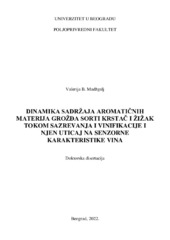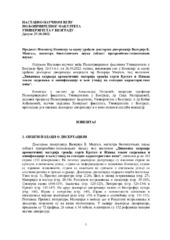Приказ основних података о дисертацији
Dinamika sadržaja aromatičnih materija grožđa sorti Krstač i Žižak tokom sazrevanja i vinifikacije i njen uticaj na senzorne karakteristike vina
Dynamics of the content of aromatic substances in grapes of the Krstač and Žižak varieties during maturation and vinification and its influence on the sensory characteristics of wine
| dc.contributor.advisor | Petrović, Aleksandar | |
| dc.contributor.other | Matijašević, Saša | |
| dc.contributor.other | Anđelković, Boban | |
| dc.creator | Madžgalj, Valerija | |
| dc.date.accessioned | 2023-09-06T11:01:55Z | |
| dc.date.available | 2023-09-06T11:01:55Z | |
| dc.date.issued | 2023-02-06 | |
| dc.identifier.uri | https://uvidok.rcub.bg.ac.rs/bitstream/handle/123456789/5080/Referat.pdf | |
| dc.identifier.uri | https://eteze.bg.ac.rs/application/showtheses?thesesId=9196 | |
| dc.identifier.uri | https://fedorabg.bg.ac.rs/fedora/get/o:30562/bdef:Content/download | |
| dc.identifier.uri | https://plus.cobiss.net/cobiss/sr/sr/bib/121767433 | |
| dc.identifier.uri | https://nardus.mpn.gov.rs/handle/123456789/21576 | |
| dc.description.abstract | Istraživanja u ovoj doktorskoj disertaciji imala su za cilj da prikažu sadržaj aromatičnih jedinjenja u grožđu i aromatični profil vina autohtonih crnogorskih sorti grožđa Krstač i Žižak. Priprema uzoraka je urađena tečno-tečnom ekstrakcijom i aromatična jedinjenja su detektovana GC/FID-MS analizom. U belim vinima, proizvedenim po raznim metodama mikrovinifikacije, identifikovani su viši alkoholi, etil estri, acetati, laktoni i masne kiseline. Primenom maceracije u trajanju 4 i 8 sati i enzimskih preparata (Lallzyme cuveé blanc i beta), utvrđeno je da je sadržaj ukupnih aromatičnih jedinjenja značajno viši u uzorcima vina K EB4h i Z CB4h, u odnosu na kontrolu. Maceracija i upotreba enzimskih preparata su povećali sadržaj 2-feniletil i izoamil alohola, zatim heksanske i oktanske kiseline. Pored toga, u svim uzorcima vina je bio povećan sadržaj estara, koji su odgovorni za voćnu aromu vina (izoamil acetat, etil heksanoat i 2-feniletil acetat), u poređenju sa kontrolom. U ovom radu ispitivan je uticaj dva kvasca i hraniva za kvasce na sadržaj aromatičnih jedinjenja. Utvrđeno je da tokom alkoholne fermentacije Saccharomyces cerevisiae sintetiše viši sadržaj ukupnih aromatičnih jedinjenja u odnosu na Saccharomyces bayanus uz dodavanje istih hraniva za kvasce. Kada u sadržaj ukupnih aromatičnih materija nisu uključeni viši alkoholi, najvišu koncentraciju aromatičnih jedinjenja imala su vina K Bay E i Z Bay E. Kvasac Saccharomyces cerevisiae sintetiše višu koncentraciju izoamil alkohola, 2-feniletil i izobutil alkohola, u odnosu na Saccharomyces bayanus. Zaključeno je, da je na stvaranje različitih koncentracija etil estara i acetata, značajan uticaj imao kvasac koji je upotrebljen u eksperimentu, dok pojedino hranivo za kvasce naglašava njegove različite karakteristike. Vina Krstača i Žižka koja su dobijena taloženjem šire u trajanju od 30 sati su imala najbolje rezultate u pogledu sadržaja ukupnih aromatičnih jedinjenja, estara i kiselina. Pored toga, sadržaj ukupnih aromatičnih jedinjenja je bio viši u vinima dobijenim fermentacijom samotoka (K sam, Z sam) u poređenju sa vinima dobijenim primenom pritiska tokom presovanja kljuka (K pres, Z pres). Vina koja su sazrevala godinu dana imala su bolje senzorne i hemijske karakteristike. Utvrđen je viši sadržaj etil estara (etil laktata, dietil sukcinata, dietil hidroksibutandioata, etil hidrogen sukcinata) i γ-butirolaktona i niže koncentracije acetata, u odnosu na vina koja nisu sazrevala. Senzornom ocenom utvrđeno je da su Krstač vina bila ćilibarne boje, imala su miris sa tonovima meda i ukus je bio umereno pun, dok su Žižak vina imala izraženiji miris sorte, prijatan ukus, umerene punoće sa solidnim kiselinima. Rezultati ovih istraživanja imaju veliki praktični značaj, jer proizvođačima vina obezbeđuju informacije o načinu vinifikacije, čime se poboljšava kvalitet belih vina. Imaju i naučni značaj jer su dali doprinos opštim saznanjima o karakteru arome vina, i prvi put su objavljeni podaci o aromatičnom profilu autohtonih sorti Krstač i Žižak. | sr |
| dc.description.abstract | The research in this doctoral dissertation aimed to show the content of aromatic compounds in grapes and the aromatic profile of the wines of autochthonous Montenegrin grapevine varieties Krstač and Žižak. The sample preparation method consisted of liquid-liquid extraction, and aromatic compounds were detected by GC/FID-MS analysis. Higher alcohols, ethyl esters, acetates, lactones and fatty acids were identified in white wines produced by various microvinification methods. Using maceration for 4 and 8 hours and enzymatic preparations (Lallzyme cuveé blanc and beta), it was determined that the content of total aromatic compounds was significantly higher in the samples of K EB4h and Z CB4h wines, compared to the control. Maceration and the use of enzyme preparations increased the content of 2-phenylethyl and isoamyl alcohol, followed by hexanoic and octanoic acid. In addition, in all wine samples, the content of esters responsible for the fruity aroma of wine (isoamyl acetate, ethyl hexanoate and 2-phenylethyl acetate) was increased, compared to the control. This paper studied the influence of two yeasts and yeast nutrients on the content of aromatic compounds. It was found that during alcoholic fermentation, Saccharomyces cerevisiae synthesizes a higher content of total aromatic compounds than Saccharomyces bayanus with the addition of the same yeast nutrients. When higher alcohols were not included in the content of total aromatic substances, the highest concentration of aromatic compounds was in the wines K Bay E and Z Bay E. The yeast Saccharomyces cerevisiae synthesizes a higher concentration of isoamyl alcohol, 2-phenylethyl and isobutyl alcohol, compared to Saccharomyces bayanus. It was concluded that the yeast used in the experiment had a significant influence on the formation of different concentrations of ethyl ester and acetate, while a particular yeast nutrient emphasizes its different characteristics. The wines of Krstač and Žižak, which were obtained by settling over a period of 30 hours, had the best results in terms of the content of total aromatic compounds, esters and acids. In addition, the content of total aromatic compounds was higher in the wines obtained by free-run juice fermentation (K sam, Z sam) compared to the wines obtained by applying pressure during mash pressing (K pres, Z pres). Wines that matured for a year had better sensory and chemical characteristics. A higher content of ethyl esters (ethyl butyrate, ethyl lactate, diethyl succinate, diethyl hydroxybutanedioate, ethyl hydrogen succinate) and γ-butyrolactone and lower acetate concentrations were determined, compared to wines that did not mature. The sensory evaluation determined that the Krstač wines were amber in colour, had an aroma with tones of honey, and the taste was moderately full, while the Žižak wines had a more pronounced aroma of the variety, a pleasant taste, moderate fullness with solid acidity. These research results have great practical importance, because they provide wine producers with information about the vinification method, which improves the quality of white wines. They are also of scientific importance, as they contribute to general knowledge about the character of the wine aroma, and information on the aromatic profile of the autochthonous Krstač and Žižak varieties are published for the first time | en |
| dc.format | application/pdf | |
| dc.language | sr | |
| dc.publisher | Универзитет у Београду, Пољопривредни факултет | sr |
| dc.rights | openAccess | en |
| dc.rights.uri | https://creativecommons.org/licenses/by-nc-nd/4.0/ | |
| dc.source | Универзитет у Београду | sr |
| dc.subject | aromatična jedinjenja | sr |
| dc.subject | aromatic compounds | en |
| dc.subject | GC/FID-MS analiza | sr |
| dc.subject | tretmani šire i vina | sr |
| dc.subject | belo vino | sr |
| dc.subject | autohtone sorte grožđa Krstač i Žižak | sr |
| dc.subject | senzorna ocena | sr |
| dc.subject | GC/FID-MS analysis | en |
| dc.subject | must and wine treatments | en |
| dc.subject | white wine | en |
| dc.subject | autochthonous grape varieties Krstač i Žižak | en |
| dc.subject | sensory evaluation | en |
| dc.title | Dinamika sadržaja aromatičnih materija grožđa sorti Krstač i Žižak tokom sazrevanja i vinifikacije i njen uticaj na senzorne karakteristike vina | sr |
| dc.title.alternative | Dynamics of the content of aromatic substances in grapes of the Krstač and Žižak varieties during maturation and vinification and its influence on the sensory characteristics of wine | en |
| dc.type | doctoralThesis | |
| dc.rights.license | BY-NC-ND | |
| dc.identifier.fulltext | http://nardus.mpn.gov.rs/bitstream/id/151646/Disertacija_13657.pdf | |
| dc.identifier.fulltext | http://nardus.mpn.gov.rs/bitstream/id/152471/Referat.pdf | |
| dc.identifier.rcub | https://hdl.handle.net/21.15107/rcub_nardus_21576 |



